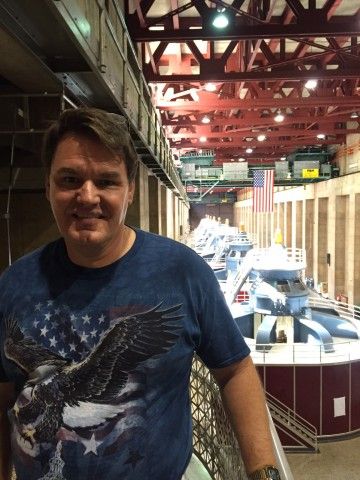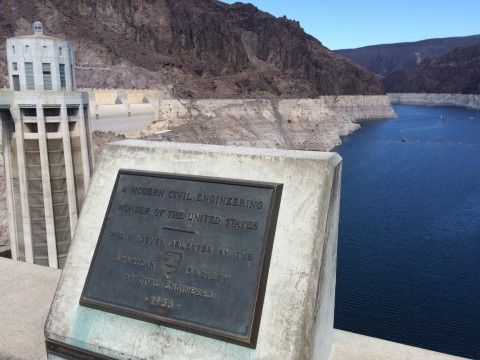AFT Blog
Inside, Outside, On Top Of and Behind the Incredible Hoover Dam
A little over 30 years ago I made a mistake. At the time I was a busy undergraduate student in mechanical engineering in California. Some students put together an official weekend trip for ME students to the Hoover Dam that included a special tour of the dam geared towards engineers and engineering students. I remember having tons of homework to do and decided not to go on the weekend trip. That was a mistake and I have regretted it ever since.
One outcome of that mistake is that I have rarely, if ever, missed another chance to go on a technical tour. Another outcome is that I have been trying to fit in a Hoover Dam visit ever since. I have been to or through Las Vegas (about 45 minutes from Hoover Dam) probably 30 times since then. But I could never find that half-day I needed to visit the dam with the other priorities I was trying to balance (usually involving my family that included four children). Until a couple of weeks ago.
Another twist for me involves the professor who taught me Statics (the study of stationary structures like dams). I was incredibly fortunate to take a Statics class when I was 19 years old from Howard Eberhart. He was an outstanding teacher and memorable character. Professor Eberhart towered over most of us students at 6' 4" (1.93 m) in height. I will never forget his steely blue eyes, bald head, and deep, gravelly voice proclaiming (for the hundredth time), "It is all...simple...statics!".
Professor Eberhart obviously knew dams and we knew he was an emeritus professor. He was 76 years old when I took his class in 1982 at the University of California at Santa Barbara but he was still dam sharp (pardon the pun). It was also widely understood among the students that he had worked on the Hoover Dam in the 1930's. It was also known he had been on the faculty at U.C. Berkeley and that the textbooks we used were from his colleagues at Berkeley. I still have those books and re-opened them for the first time in 25 years last week to confirm what I suspected. Namely, that Professor Eberhart was mentioned by the authors in the foreword of the books. How he got to Santa Barbara I could not find out, but he apparently kept teaching undergraduates at UCSB until he was 85.
After my recent visit to Hoover Dam (more on that shortly) I decided to do some research on Professor Eberhart. I could not find anything that definitively stated he did any work on the Hoover Dam. He was a graduate student at Berkeley in Civil Engineering when the dam was being built in the early 1930's. His graduate school advisor R.E. Davis did work on materials research on the Hoover Dam so I suppose it is possible Professor Eberhart made a contribution to the Hoover Dam as a graduate student researcher. I discovered he did work on the Oroville Dam in California (the tallest dam in the United States at 770 feet (230 m) high - see this link). It appears that he also worked on the Grand Coulee Dam in the U.S. state of Washington (see this link).
Professor Eberhart was elected to the National Academy of Engineering in 1977, something I never knew but was not surprised to discover. He also was an expert in prosthetic device design and himself was an amputee, both of which I never knew. That he was an amputee and had a prosthetic leg explained the limp he walked with even though he never mentioned anything about it.
I will never forget Professor Eberhart.
Professor Howard Eberhart - My Statics Instructor in 1982 at UCSB and Member of the National Academy of Engineering

My Hoover Dam Visit
With that lengthy, personal preamble, let me move on to my visit to Hoover Dam. My wife and I reserved a tour of the Hoover Dam Power Plant. The tour takes visitors on an elevator down 530 ft (162 m) to the penstock viewing area and the turbine house on the Nevada side. It also gives background on how the dam was built, as does the excellent Hoover Dam Visitor Center.
One of the interesting things I discovered on the tour was that when the concrete for the dam was poured they placed cooling pipes in the concrete. If they had not done that, it would have taken over a hundred years for the dam concrete to cool and cure and reach full strength. They built a refrigeration plant at the dam when it was built to run chilled water through those pipes to cool the concrete. The pipes are still inside the concrete although not needed any more. There was and still is 582 miles (937 km) of pipe in the dam.
It is worth mentioning that AFT software has direct applications to hydroelectric power. When turbine transients occur, waterhammer occurs in the penstock supply pipe. Simulating this is an important part of hydroelectric dam design, and our most recent version of AFT Impulse (version 6) added a hydroelectric turbine junction.
The dam was an astounding feat of engineering when completed in 1936. Upon completion it took over six years for the Lake behind the dam to fill up.
In case you are in the area and interested, the tour I went on and recommend is the Hoover Dam Power Plant Tour. Below are some photos I took on the tour.
Hoover Dam from the Nevada Side
Penstock to Turbines on Nevada Side - 30 ft (9.1 m) Diameter
Hoover Dam Turbine House on Nevada Side
Me at the Hoover Dam Turbine House
Discharge of Hoover Dam and Turbine Houses for Arizona Side (at bottom left) and Nevada Side (at bottom right) with Colorado River Flowing Down Canyon
ASCE Plaque for Hoover Dam From 1955 with Intake Structure at Left and Lake Mead Behind the Dam









Comments